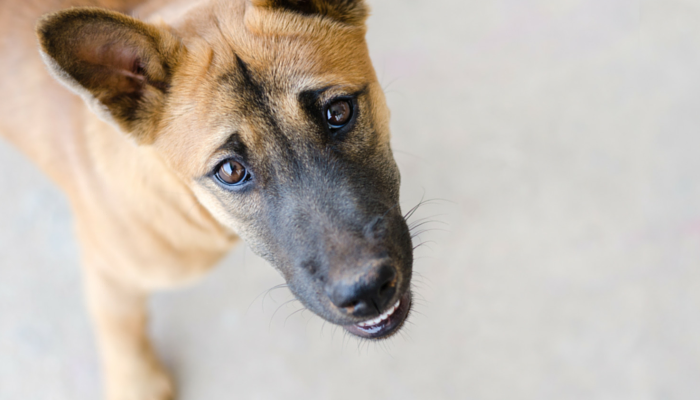5 Things Not to Do When Teaching Your Puppy Not to Bite
Laika wasn’t easy when it came to teaching bite inhibition. I heard that Shepherds were supposedly notorious for being bitey faces, but I had no idea…
I had no idea that a 40 pound puppy could make me, a grown woman, run away screaming for dear life, but she did – and she did it many, many times. In those first couple of weeks I learned a lot about how to make the biting stop, but more importantly I learned what not to do when they start coming at you with that mouthful of razor sharp enamel they call puppy teeth.
So why did teaching Laika bite inhibition take so long? Because I was sending out a lot of mixed signals by yelping, running around like a madman and having a hard time being consistent. Here’s 5 things NOT to do when teaching your puppy not to bite.
Don’t Run Around Like a Madman Trying to Get Away
No one likes being bitten by those sharp little puppy teeth. I know it’s just a puppy and all, but they hurt much more than you’d expect. So naturally, when your puppy starts biting your hand or pants your first instinct is to get away. I mean if you put your hand on a hot stove you move it, that same principle applies to getting the hell away from whatever the hell is biting you.
But be careful when it comes to how you decide to move away. Remain calm. Don’t flap your hands around in the air, scream and run away like a madman. I know you’ll want to – because it friggin hurts – but try your best to remain calm. You see when you run around like crazy trying to avoid a biting puppy that can send them into frenzy mode – and trust me you don’t want to get bit when they’re in frenzy mode.
When you run away from a puppy while screaming or flapping around you’re going to look like a super fun toy to your pup. Dogs love to chase things, and that love is even stronger for exciting things – things that scream, flail around and move fast.
Don’t turn yourself into a dog toy. When your puppy starts biting you try your best to remain calm. Remove yourself from the situation as calmly as possible to avoid stimulating them further.
Don’t “Yelp” and Scream Loudly to Startle/Shock Your Dog Out of It
Conventional wisdom once told us that yelping at a puppy whose biting will make them stop. The yelping method is supposed to tell your puppy that ‘ow, that really hurts’ and then they’ll just miraculously cease biting.
Well that doesn’t always work out so well, and can actually make them bite more. It certainly didn’t work for me, and if the comments on my Try Yelping They Said post are any indication it didn’t work for any of your either.
Are us humans incapable of vocalizing a yelp of pain that resonates with puppy brains? Do our dogs know we’re faking it? My dog stops when she hears my real ow noises, but when I try to come up with a yelp she just looks at me like a giant chew toy.
Honestly I don’t know why the yelping method doesn’t work for many dogs. I assume that the high pitched noise many of us making when we try to emulate yelping just excites puppies even more. What I do know is that when I tried it I instantly regretted it because my dog started biting me even harder.
Don’t Forget to Offer Your Dog Something Other Than Your Arm to Chew On
Puppies need stuff to chew on, and many of us do provide our pups with plenty of toys & chew toys to fill that need. But what we often forget to do is have them on hand at all times.
Now I’m not saying you absolutely need to stash a bunch of toys in your pockets, but you should at least have a toy nearby for when the biting begins. When it comes to teaching your puppy not to bite it’s important to be prepared. And when I say be prepared I mean be armed with toys at all times if need be.
I don’t know if Laika was the exception to the rule or if all pups are particularly nasty, but we had hundreds of ‘hurry up and put a toy in her mouth’ moments. After a couple of days I learned that having a toy nearby at all times really helps.
When you’re playing with your puppy and they start to chew on your fingers (inevitable) hand them a fun toy instead. Now not all toys are extremely exciting to puppies, especially compared to wiggly fingers or toes. Make that toy just as exciting as your flesh by shaking it and moving it around. Remember you need to make their redirection target ( the toy ) more exciting than their fun squealing human target ( you ).
Quit Roughhousing When Your Puppy Gets Over Stimulated and/or Bitey
Playing tug and wrestling with a puppy can be a lot of fun, but they can also lead to over stimulation. When puppies get super excited learning goes out the window.
I rough house and play tug with Laika all the time; but when she was a puppy I had to really watch how excited she was getting during play. Before she had a good handle on basic bite inhibition those games were pretty much an invitation for her to go hog wild & bite anything in sight. I was setting her up for failure.
There is no set rule on what games you can and cannot play with your pup. Interactive play like a game of tug can be an excellent way to teach your dog some manners and impulse control, but their little puppy brains can get over excited. And what happens to an excited puppy brain? Well they have a tendency to start biting.
You know your dog best, and you’re the best judge of what’s too much when it comes to getting them riled up. If your puppy isn’t yet fully trained on not biting a game of tug might be too much.
If you’re going to play tug with your puppy make sure you stay consistent with a set of rules. For me the biggest rule of all is ‘the game stops if your teeth touch my skin.’ And if your puppy seems unable to control himself ( and his teeth ) with a games of tug take a break and work on some more basic bite inhibition work.
If you’re roughhousing with your dog, make sure to be aware of his arousal levels and to pause every minute or so to help him settle. This is a good time to practice and reward a sit or a down command. You want your dog to be able to calm down and obey you, even in “exciting” scenarios such as intense play. – Do You Play Fight With Your Dog?, That Mutt
Don’t Send Your Dog Mixed Signals
When it comes to teaching your dog not to bite it’s important to remain consistent. Many times the problem in consistency comes in when not all members of the family are on board.
If you don’t want your puppy to bite it’s important to make it a set rule that applies to everyone. Your husband might be rough-housing and getting bit by baby Rover in the living room, but you don’t want that behavior to get transferred onto grandma.
It’s a lot like teaching your dog not to beg for food. Once everyone is on board and refusing to give in it’s a lot easier to teach. One little slip up like but he looked so hungry, it was just a little piece of bacon will teach your dog that begging works, and he might as well keep doing it because the result will be yummy yummy bacon.
Make sure everyone in the family knows that teaching your puppy not to bite is a priority. I know it’s funny to watch Sally get chased around by a little bitey puppy, but that’s not how you want your dog to act around grandma, the mailman or your neighbors.
If you want your dog to learn to stop biting you need to be consistent. Everyone needs to be on board, and everyone needs to discourage biting by offering a toy instead. Every little slip up where the behavior is allowed ( or encouraged ) will lead to confusion when your dog is punished for it later.
Inconsistency is unfair. One minute your dog gets away with or is rewarded for a bad behavior and the next minute he is chastised and/or punished for the same act. This type of environment makes it hard, if not impossible to learn. – Consistency
How Did You Teach Your Puppy Not to Bite?
How did you teach your puppy not to bite? Did you use the redirection method with a fun toy? Did you try the yelping method with your dog? Did it work or just excite your dog even more?

